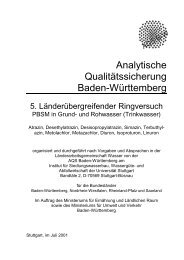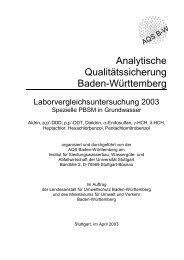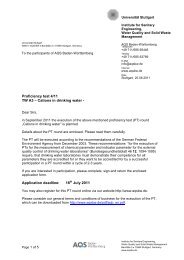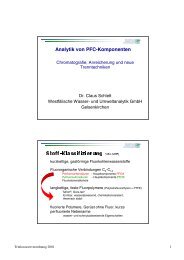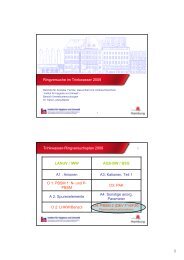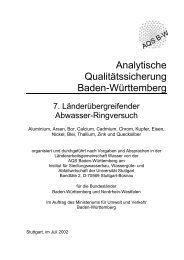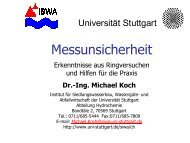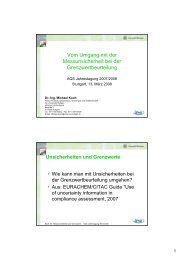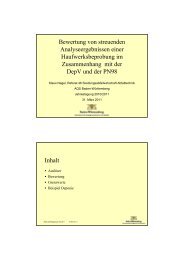Institute for Sanitary Engineering, Water Quality and Solid Waste ...
Institute for Sanitary Engineering, Water Quality and Solid Waste ...
Institute for Sanitary Engineering, Water Quality and Solid Waste ...
You also want an ePaper? Increase the reach of your titles
YUMPU automatically turns print PDFs into web optimized ePapers that Google loves.
Chair of <strong>Waste</strong> Management <strong>and</strong> Emissions<br />
Monitoring of bentzotriazole in the Stuttgart<br />
water sanitation plant, extended by degradation<br />
experiments of carbamazepine.<br />
The concentrations of 1-H-benzotriazol, 4-methyl-1-<br />
H-benzotriazol <strong>and</strong> 5-methyl-1-H-benzotriazol were<br />
monitored in the Stuttgart water sanitation plant. There<strong>for</strong>e<br />
a new HPLC-MS method was developed in the<br />
labioratories of the L<strong>and</strong>eswasserversorgung in Langenau.<br />
Samples from all five water sanitations plants in Stuttgart<br />
were examiened. The results showed, that 4-methyl-1-H-benzotriazol<br />
is not degraded, while 1-H-benzotriazol<br />
<strong>and</strong> 5-methyl-1-H-benzotriazol is eliminated<br />
up to 70%.<br />
tryptone <strong>and</strong> glucose. Citrate was identified as a suitable<br />
electron donor used by CRM100 during the biological<br />
Cr(VI) reduction achieving the hightest Cr(VI)<br />
reduction (99.7%) within a period of 7 days under 100<br />
mg/L. The results suggested that the isolated strain<br />
CRM100 can be used <strong>for</strong> treating industrial wastewater<br />
containing chromium hexavalent.<br />
Diego Salamanca (WAREM) 2009<br />
Supervisor: Dr. N. Strunk<br />
Master Thesis<br />
In parallel it was tried to enrich a bacterial strain or<br />
community, which mineralize or trans<strong>for</strong>m carbamazepine.<br />
This substrate possesses only a low solubility<br />
in water. Hence, no bacterial strain, which uses carbamazepine<br />
as sole source of carbon <strong>and</strong> energy could<br />
be enriched. But it was possible to identify one strain,<br />
which uses carbamazepine as source of nitrogen.<br />
Ngoc Diep Van (Umweltschutztechnik) 2009<br />
Supervisor: Dr. N. Strunk<br />
Independent Study<br />
The strain CRM100 growth on citrate <strong>and</strong> chromium(VI).<br />
Visible is the production of Cr(III) compounds.<br />
Structure of the substrates<br />
Physiology <strong>and</strong> possible industrial application of<br />
Cr(VI) reduction using biological systems<br />
Treatment of hexavalent chromium contaminated<br />
wastewater<br />
“Treatment of hexavalent chromium contaminated<br />
wastewater”. A Bacterial strain (CRM100) isolated<br />
from a mixture of wastewater <strong>and</strong> soil taken from the<br />
treatment plant <strong>and</strong> boundaries of ISWA department<br />
respectively, was capable to reduce Cr(VI) concentration<br />
from an initial concentration 100 mg/L Cr(VI) to<br />
0.27 mg/L Cr(VI) using citrate as carbon source. Moreover,<br />
experiments were carried out to determine the<br />
growth of bacteria <strong>and</strong> the Cr(VI) reduction in presence<br />
of different carbon sources such as lactate, pyruvate,<br />
citrate, acetate, glycerol, D-xylose, acetone,<br />
The study was conducted to evaluate the biological reduction<br />
of Cr(VI) as a possible treatment in industrial<br />
wastewater. The bacterial strain CRM100 was resistant<br />
to 1800 mg/L Cr(VI) <strong>and</strong> able to reduce 99.8% of 100<br />
mg/L Cr(VI) using citrate as carbon source under anaerobic<br />
conditions. CRM100 reduced 78% of 1000 mg/L<br />
Cr(VI) within a period of 18 days. The biological Cr(VI)<br />
resistance of CRM100 was compared with P. putida.<br />
CRM100 was 180 times more resistant than P. putida.<br />
The growth of P. putida was inhibited by Cr(VI) concentrations<br />
higher than 10 mg/L Cr(VI). The influence<br />
of factors as pH, initial concentration of carbon source<br />
<strong>and</strong> Cr(VI) concentration was evaluated to determine<br />
the optimal reduction process using bacterial strain<br />
CRM100. The biological growth was affected when the<br />
112




